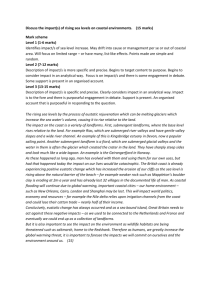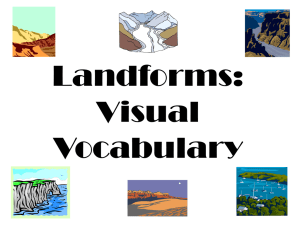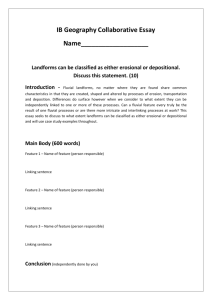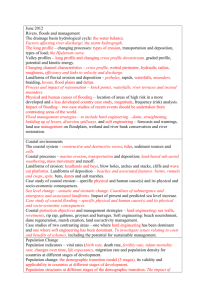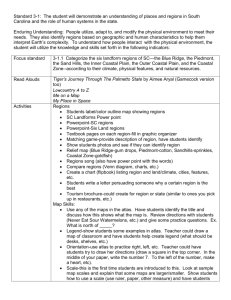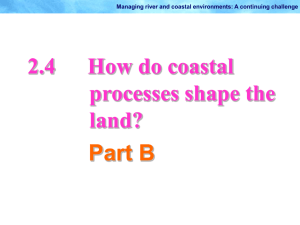Scheme of work - geographylwc.org.uk
advertisement
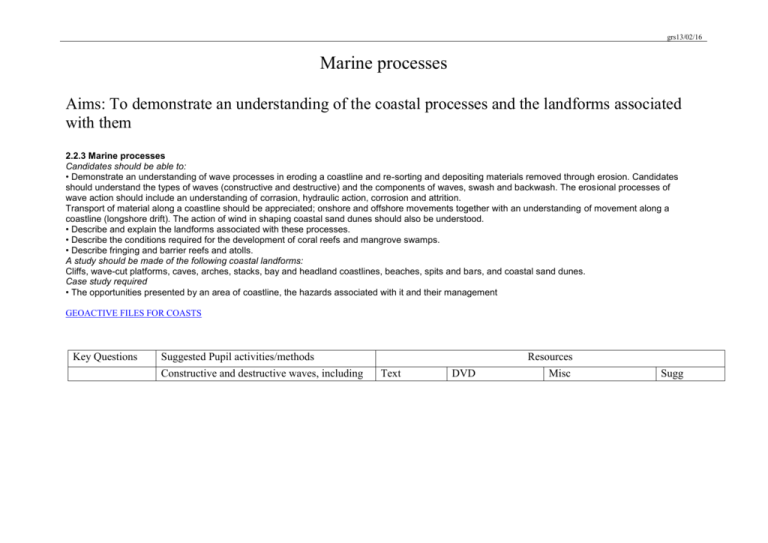
grs13/02/16 Marine processes Aims: To demonstrate an understanding of the coastal processes and the landforms associated with them 2.2.3 Marine processes Candidates should be able to: • Demonstrate an understanding of wave processes in eroding a coastline and re-sorting and depositing materials removed through erosion. Candidates should understand the types of waves (constructive and destructive) and the components of waves, swash and backwash. The erosional processes of wave action should include an understanding of corrasion, hydraulic action, corrosion and attrition. Transport of material along a coastline should be appreciated; onshore and offshore movements together with an understanding of movement along a coastline (longshore drift). The action of wind in shaping coastal sand dunes should also be understood. • Describe and explain the landforms associated with these processes. • Describe the conditions required for the development of coral reefs and mangrove swamps. • Describe fringing and barrier reefs and atolls. A study should be made of the following coastal landforms: Cliffs, wave-cut platforms, caves, arches, stacks, bay and headland coastlines, beaches, spits and bars, and coastal sand dunes. Case study required • The opportunities presented by an area of coastline, the hazards associated with it and their management GEOACTIVE FILES FOR COASTS Key Questions Suggested Pupil activities/methods Constructive and destructive waves, including Resources Text DVD Misc Sugg grs13/02/16 What processes shape the coastal zone? What are the landforms that result from erosional processes? swash and backwash Wave refraction Erosion process: hyd action, abrasion (corrosion) , attrition, and solution (corrosion) Transportation processes: traction, saltation, suspension, solution and LSD Deposition and the reason for it IT EX ON WAVES Discuss formation of headlands and bays: cliff, stacks, etc. use examples from Purbeck. Case Study; Purbeck 12 Apostles, S Australia 12 77 78 IT EX ON EROSIONAL LANDFORMS What are the landforms that result form deposition? Discussion of beach landforms; backshore, foreshore, offshore. Description of spits and bars. Interpretation of photos and annotated sketches. Use Studland as an example of a spit. Also mention barrier beaches, tombolas and cuspate forelands Case Study: Hurst Castle Spit/Spurn Head? IT EX ON LONGSHORE DRIFT AND DEPOSITIONAL FEATURES PPT on dep landforms G&N 75 Bunnett P 53 81 12 43 And Coasts G&N 77 GinPAcc 14A,B,C,D GinPHC 14A GinPHC 14C The work of the sea GeoA 8155, 13258, 19386 Key Act 2.1 Key Ass2.2 Und Geog TRP P 79 Skills Paper 21 June 10 qu 3 Und Geog skills Worksheet G&N 78 12 43 And Coasts GinPAcc 14E NewWWTeach P124 GinPHC 14G Key Act 2.2 The work of the sea Key Ass 2.1 Skills Paper Nov 09 qu 5 Link to OS maps, Swanage, Milford Haven Newhaven Padstow Link to OS maps Great Yarmouth Weymouth grs13/02/16 How are coastal sand dunes and salt marshes constructed? Describe the process of sand dune construction, Use diagrams. Egs Studland and ?? Describe how salt marshes develop, focus on bio construction. Use diagrams. Studland again G&N 80 Sand dune plants GeoFact119 Bunnett 150 Sample qu Mark scheme How are coral reefs formed? What are the pressures on the reef? Describe the growth and types of reef, fringing, barrier and atoll Outline the issues of use, e.g. tourism Kenya, Also west Indies Sample qu; mark scheme Coastal Holderness map 1997 Management focused for Alt to cwk paper 82 G&N 81 Bunnett P 148 AQA 167 GeoFact 124 Salt marsh G&N 82 GeoA 19392 GeoFact 118 Wideworld, 13 Briggs P 48 Wideworld 22,2 Types of reef Atoll case study Great Barrier Reef Jim & Betty mystery



